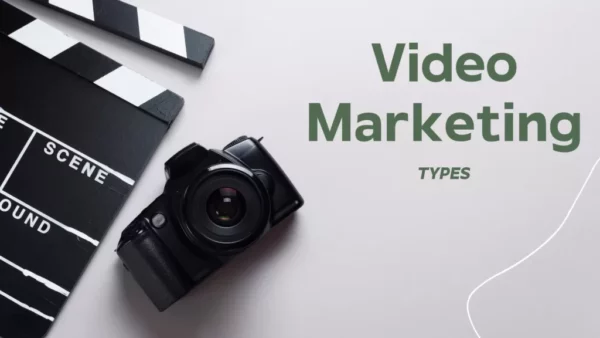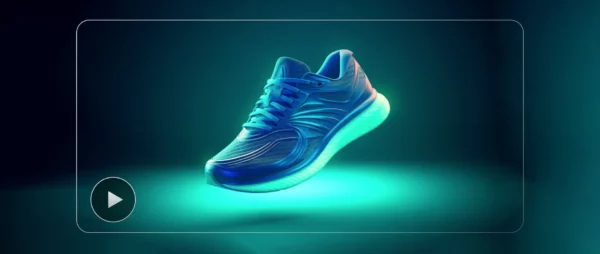Video marketing has become an increasingly popular strategy for businesses looking to engage with their audience and increase conversions. With the rise of ecommerce, video marketing is currently even more important as businesses aim to stand out in a crowded online marketplace. The contemporary target audience is highly visual and has many forms of content fighting for attention.
Perhaps a simplified definition of video marketing is needed before we dive deeper into the concept. Video marketing refers to the use of videos to inform your audience about a specific product or service. The process of video marketing involves planning, creating, editing, and publishing videos to promote a brand. The videos created are often shared across different platforms, whether it is through programmatic advertising, on the website, or on social media.

In this article, we will explore the benefits of video marketing in ecommerce and provide strategies for businesses in the e-commerce space looking to incorporate video into their marketing efforts.
Understanding Video Marketing
Video marketing is a powerful tool that can help you increase engagement, drive traffic, and boost conversions. These present some of the primary goals for engaging in any marketing efforts for your brand. Video marketing involves creating and sharing videos that promote your brand, products, or services.
With the rise of social media platforms and the increasing popularity of video content, video marketing has become a crucial strategy for ecommerce businesses. Video content is more engaging and memorable than text or images alone, making it an effective tool for increasing brand awareness, driving traffic, and boosting sales. Statistically, only 20% of users will read content, compared to 80% who will most likely watch a video and engage with it.
Overall, video marketing is a powerful tool for ecommerce businesses looking to increase their online presence and drive sales. By creating engaging and informative video content, your business can showcase its products, build trust with your audience, and ultimately boost your bottom line.
Benefits of Video Marketing

Video marketing has several benefits that make it an effective strategy for ecommerce businesses. With a significant reduction in the attention span of today’s target audiences and potential customers, careful and effective implementation of videos in your marketing strategy can make a huge difference for your e-commerce business. Here are some of the key advantages:
- Increased engagement: Videos are more engaging than text or images alone. They capture attention and keep viewers interested for longer periods of time, giving you the opportunity to adequately showcase your product or service.
- Improved SEO: Videos can help improve your search engine rankings by increasing the time users spend on your website and reducing bounce rates.
- Better conversions: Videos can be used to showcase your products or services in action, which can help boost conversions by giving customers a better understanding of what you offer and the advantages of making a purchase.
- Greater reach: Videos can be shared on social media platforms, which can help you reach a wider audience and increase brand awareness. Greate
Types of Video Marketing in Ecommerce

Video marketing can be used in many ways in ecommerce. Here are some examples:
- Product demos: Videos can be used to showcase your products in action, giving customers a better understanding of how the products work and what they can do.
- Customer testimonials: Videos can be used to share customer testimonials, which can help build trust and credibility with potential customers.
- How-to videos: Videos can be used to provide customers with step-by-step instructions on how to use our products or services.
- Behind-the-scenes videos: Videos can be used to give customers a behind-the-scenes look at our business, which can help build a stronger connection with our brand.
Overall, video marketing is a powerful tool that can help us increase engagement, drive traffic, and boost conversions in ecommerce. By using videos strategically, we can create a more engaging and memorable experience for our customers.
Video Marketing Strategies
Video marketing is a powerful tool to increase brand awareness, engagement, and conversion rates. To make the most out of your video marketing efforts, you need to implement the right set of video marketing strategies by adopting best practices. Here are some effective video marketing practices that you can use to promote your ecommerce business:
1. Creating Engaging Content

Creating engaging video content is critical to the success of your video marketing campaign. As already mentioned, today’s audiences have many forms of content competing for their attention on the internet. Your video content should be precise, informative, entertaining, and relevant to your target audience. Use storytelling techniques to engage your viewers and keep them interested in your video content. This speaks to the psychology of humans, who are believed to be wired for face-to-face connection. Videos also stimulate people’s senses more than texts or images but only if you make them engaging, high-quality, and valuable.
2. Optimizing for SEO
Optimizing your video content for search engines is essential to increase its visibility and reach. The role of SEO is to generate organic traffic to your website and increase conversions and sales. Use relevant keywords in your video title, description, and tags. Also, include a transcript of your video content to make it easier for search engines to crawl and index your video content. When you implement this strategy effectively, you will join the other 92% of marketers who agree that video marketing is a critical component of their marketing strategy.
3. Leveraging Social Media
Social media platforms are an excellent way to promote your video content and reach a wider audience as more people rely on these platforms to get information. You can take advantage of the new user dynamic by sharing your video content on social media platforms like Facebook, Twitter, Instagram, and LinkedIn. Use hashtags, captions, and descriptions to increase the visibility of your video content on social media.

4. Measuring Success
Measuring the success of your video marketing campaign is critical to optimize your video marketing strategies. It is also the best way to know whether your video marketing efforts are earning the expected return on investment(ROI) Use analytics tools to track the performance of your video content, including views, engagement, and conversion rates. Use this data to refine your video marketing strategies and boost the performance of your video content. You are assured of a good ROI when you implement it effectively.
5. Choosing the Right Platform
When it comes to video marketing, choosing the right platform is crucial. There are many options available, including YouTube, Vimeo, Facebook, Instagram, TikTok, and your ecommerce website. It’s important to consider your target audience and where they are most likely to engage with your content. For example, if you’re targeting a younger demographic, TikTok may be the best option. If you’re targeting professionals, LinkedIn may be a better fit. No matter the platform you choose, make sure that it is mobile-friendly for a positive user experience and reduced bounce rates. The goal is to increase the time users spend on your pages through engaging video content on preferred platforms.
6. Creating Product Videos

Product videos are a powerful tool for ecommerce businesses. At the end of the day, you want to advertise your products and services to potential customers and increase sales. Video marketing allows you to showcase your products in action and provide potential customers with a better understanding of what you offer. When creating product videos, it’s important to keep them short and to the point, focusing more on the functionality of the product. Highlight the key features and benefits of your products and show them in use. Consider using customer testimonials to add credibility and social proof because other than brand recognition, you also want the potential customers to trust you.
7. Using Live Video
Live video is another effective way to engage with your audience and build trust. It allows you to interact with your audience in real time and answer their questions on the spot. When using live video, it’s important to have a clear plan and structure in place. Consider hosting Q&A sessions, product demos, or behind-the-scenes looks at your business.
By following these key steps, you can successfully implement a video marketing strategy for your ecommerce business. Remember to keep your content engaging, informative, valuable, and targeted to your audience.
Challenges and Solutions in Video Marketing

As with any marketing strategy, video marketing comes with its own set of challenges. In this section, we will discuss some common challenges faced by ecommerce businesses when it comes to video marketing, and their solutions.
Dealing with Budget Constraints
The main challenge faced by ecommerce businesses is budget constraints. Creating high-quality videos can be expensive, and not all businesses have the resources to invest in professional video production. However, there are several solutions to overcome this challenge.
- DIY Videos: One cost-effective solution is to create videos in-house using a smartphone or a basic camera. While the quality may not be as high as a professionally produced video, it can still be effective in engaging customers.
- User-Generated Content: Another solution is to encourage customers to create and share their own videos featuring your products. This approach not only saves money but also creates a sense of community around your brand and cultivates trust in potential customers.
Future of Video Marketing in Ecommerce
As the world of e-commerce continues to evolve, so do the trends in video marketing. Here are some future trends that you should expect to see in the coming years:

1. Interactive Videos
Interactive videos are a great way to engage with your audience and provide a more immersive experience. You can use interactive videos to showcase your products and allow customers to explore them in more detail. This can help increase customer engagement and ultimately lead to more sales. Including a clickable call to action is an example of how you can make your videos interactive.
2. Personalized Videos
Personalization is becoming increasingly important in the world of e-commerce, and video marketing is no exception. By creating personalized videos for your customers, you can help build stronger relationships and increase customer loyalty. For example, you can create personalized product demos or tutorials that are tailored to each customer’s specific needs and interests.
3. Live Streaming
Live streaming has become incredibly popular in recent years, and it’s easy to see why. By using live streaming, you can connect with your audience in real time and create a sense of urgency around your products. This can help increase sales and create a more engaging experience for your customers.
4. 360-Degree Videos
360-degree videos are a great way to showcase your products and provide a more immersive and enhanced virtual experience for your customers. By allowing customers to explore your products from every angle, you can help increase customer engagement and ultimately lead to more sales.
Overall, video marketing is an incredibly powerful tool for e-commerce businesses, and these future trends are just the beginning. By staying on top of the latest trends and technologies, you can continue to create engaging and effective video marketing campaigns that drive results.

Conclusion
In conclusion, video marketing can be an incredibly effective strategy for ecommerce businesses looking to increase their visibility, engagement, and conversion rates. By implementing the right set of video marketing strategies, you can create captivating videos that resonate with your target audience and drive them to take action.
Throughout this article, we have explored a variety of video marketing strategies, including product demos, customer testimonials, how-to videos, and more. We have also discussed the importance of optimizing your videos for search engines, social media, and mobile devices.
Remember, the key to success with video marketing is to focus on creating high-quality, engaging content that provides value to your audience. By doing so, you will be able to build trust and credibility with your customers, which can ultimately lead to increased sales and ROI.
So what are you waiting for? Start incorporating video into your ecommerce marketing strategy today and see the results for yourself!


